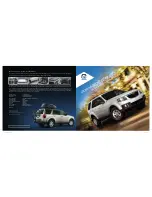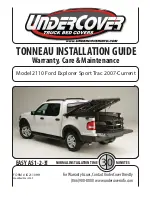
WWW.MANUALS.WS
WWW.MANUALS.WS
204
Check the tires regularly for damage
such as cuts, splits and cracks. If any
damage is found, consult with a tech-
nician and have the tire repaired or re-
placed.
Even if the damage does not appear seri-
ous, a qualified technician should ex-
amine the damage. Objects which have
penetrated the tire may have caused in-
ternal damage.
Any tires which are over six years old
must be checked by a qualified techni-
cian even if damage is not obvious.
Tires deteriorate with age even if they
have never or seldom been used.
This also applies to the spare tire and tires
stored for future use.
REPLACING YOUR TIRES
When replacing a tire, use only the
same size and construction as origi-
nally installed and with the same or
greater load capacity.
Using any other size or type of tire may se-
riously affect handling, ride, speedomeet-
er/odometer calibration, ground clear-
ance, and clearance between the body
and tires or snow chains.
CAUTION
!
Do not mix radial, bias belted, or
bias-ply tires on your vehicle. It
can cause dangerous handling
characteristics, resulting in loss
of control.
Do not use tire or wheels other
than the manufacturer’s recom-
mended size.
Toyota recommends all four tires, or at
least both of the front or rear tires be
replaced at a time as a set.
See “If you have a flat tire” in Part 4 for tire
change procedure.
When a tire is replaced, the wheel
should always be balanced.
An unbalanced wheel may affect vehicle
handling and tire life. Wheels can get out
of balance with regular use and should
therefore be balanced occasionally.
When replacing a tubeless tire, the air
valve should also be replaced with a
new one.
To equalize tire wear and help extend
tire life, Toyota recommends that you
rotate your tires every 12000 km (7500
miles). However, the most appropriate
timing for tire rotation may vary ac-
cording to your driving habits and
road surface conditions.
See “If you have a flat tire” in Part 4 for tire
change procedure.
When rotating tires, check for even wear
and damage. Abnormal wear is usually
caused by incorrect tire pressure, improp-
er wheel alignment, out-of-balance
wheels, or severe braking.
Rotating tires
Summary of Contents for 4Runner 1997
Page 56: ...WWW MANUALS WS WWW MANUALS WS 62...
Page 64: ...WWW MANUALS WS WWW MANUALS WS 70...
Page 86: ...WWW MANUALS WS WWW MANUALS WS 92...
Page 128: ...WWW MANUALS WS WWW MANUALS WS 134...
Page 142: ...WWW MANUALS WS WWW MANUALS WS 148...
Page 154: ...WWW MANUALS WS WWW MANUALS WS 160...
Page 178: ...WWW MANUALS WS WWW MANUALS WS 184...
Page 184: ...WWW MANUALS WS WWW MANUALS WS 190...
Page 192: ...WWW MANUALS WS WWW MANUALS WS 198...
Page 218: ...WWW MANUALS WS WWW MANUALS WS 224...
















































